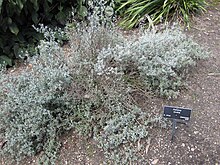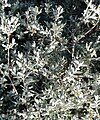Pteronia
| Pteronia | |
|---|---|

| |
| Pteronia incana | |
| Scientific classification | |
| Kingdom: | Plantae
|
| (unranked): | Angiosperms
|
| (unranked): | |
| (unranked): | |
| Order: | |
| Family: | |
| Tribe: | |
| Genus: | Pteronia |
| Type species | |
| Synonyms | |
| |
Pteronia ("Resin daisies") is a genus of evergreen, woody perennial plants assigned to the Sunflower family with currently 76 described species. Like in almost all Asteraceae, the individual flowers are 5-merous, small and clustered in typical heads, surrounded by an involucre of bracts. In Pteronia, the centre of the head is taken by relatively few, yellow, disc florets, while a ring of ligulate florets is absent. These florets sit on a common base (or receptacle).[1][2][3][4]
Taxonomy[]
A species of Gombos was first described and assigned to the new genus Pteronia by the famous Swedish naturalist Carl Linnaeus in the second edition of his groundbreaking Species Plantarum, the starting point of modern botanical nomenclature, that was published in 1763. He had not seen living plants or dried herbarium specimens, but based his description on an etching made by the English botanist Leonard Plukenet in 1700. This etching probably represents , which has been chosen as type species of the genus. In 1917, John Hutchinson and Edwin Percy Phillips revised the genus and recognised 61 species.[1]
Description[]
Gombos species are all evergreen, woody perennial plants of 0.3–1.5 m (1 ft 0 in – 4 ft 11 in) high that often contain aromatic substances. It mostly has hairless or variably hairy or glandular, wand-like (or virgate) branches, but sometimes the branches have wider angles (or divaricate). The leaves are mostly arranged in a cross, in some in a spiral or alternate, and rarely opposite and may also be hairless, variously hairy and glandular, or have a row of hairs around the margin.[1]
Ecology[]
Gombos species can mostly be found in dry habitats.[1]
Distribution[]
The species of Pteronia can be found in Botswana, Mozambique, Lesotho, Namibia, South Africa, Swaziland, Zambia and Zimbabwe. About 50 species occur in the Cape Floristic Region, particularly in the Succulent Karoo and to a lesser extend in the Nama Karoo biomes. In Namibia 24 species are found.[1]
Species list[]
It contains the following species:
- , Paraffienbos
- Pteronia glauca, Geelboegoekaroo
- Pteronia incana, Asbos
- , Boegoebos
- Pteronia oppositifolia
- Pteronia pallens, Scholtzbos
- Pteronia paniculata, Gombos
- Pteronia spinulosa
Gallery[]

Pteronia paniculata ("Gombos")

Pteronia pallens ("Scholtzbos")

("Paraffienbos")

Pteronia incana ("Asbos")

| Wikimedia Commons has media related to Pteronia. |
References[]
- ^ a b c d e Bello, Anifat Olayemi (2018). A Systematic Study of Pteronia L. (Asteraceae) (PhD thesis). University of Johannesburg.
- ^ "Search - Technische Informationsbibliothek (TIB)".
- ^ Pteronia incana
- ^ https://www.researchgate.net/publication/320034376_A_taxonomic_revision_of_the_Pteronia_camphorata_group_Astereae_Asteraceae
- Pteronia
- Asteraceae genera




